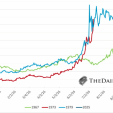Hedonics, Food And Pluralistic Ignorance

Inflation is alive and well – despite what we hear from the mainstream. Due to pluralistic ignorance, it persists much longer than anyone would have ever predicted.
From Wikipedia:
Pluralistic ignorance
“In social psychology, pluralistic ignorance is a situation in which a majority of group members privately reject a norm, but incorrectly assume that most others accept it, and therefore go along with it.[1] This is also described as ‘no one believes, but everyone thinks that everyone believes’.”
In short, pluralistic ignorance is a bias about a social group, held by a social group.
An article written by Martin Gansberg for the March 27, 1963 issue of The New York Times highlights an absurd case of a woman’s (Kitty Genovese) brutal murder. During this crime, 38 of her neighbors were able to hear her screams and retell the incident. Yet nobody went to help her and only a few actually called the police. Pluralistic Ignorance can be attributed to this case due to the fact that many heard her screams for help and knew she was dying yet nobody did anything to help. Everyone similarly assumed someone else would help and that it was not their place to get involved. No witnesses came forward until after the body was pronounced dead and carried from the crime scene.
Also known as the bystander effect, from a monetary perspective, it is operating on a massive scale, from asset valuation (including bonds and equities), to the intrinsic value of foreign exchange and currencies backed by a tenuous faith.
CPI Lies
Everyone knows that official inflation statistics are an academically-derived phenomenon and not a representation of reality. But most assume that everyone else accepts it too, as “all we have to work with”.
No one really believes government statistics, but everyone thinks that everyone believes, so it’s accepted.
For example, on an individual level, many are aware that (using BLS CPI numbers):
From 1914 to Sept. 1971 (57 years), Rent CPI goes up 133%.
Next 43 years, rent goes up 458%.
Hedonic Massage
Data is collected from retail stores and adjusted by specialists to reflect changes in quantity of a product offered or an increase in quality.
Much of the drop in prices for electronics reflects an increase in quality over the past 10 years.
Ah, so the drop in prices in not actually a drop in prices which very well may be rising… but simply “an increase in quality.”
Things really are quite great because, through the magic of hedonics, most things are really cheaper than ever.
Since the 1980s, for instance, the real price of a midrange color television has plummeted about tenfold, and televisions today are crisper, bigger, lighter and often Internet-connected.
Similarly, the effective price of clothing, bicycles, small appliances, processed foods — virtually anything produced in a factory — has followed a downward trajectory. The result is that Americans can buy much more stuff at bargain prices.
They can.
It doesn’t matter that the technology appears more advanced. To see the advantage, you would need to spend hundreds or thousands of dollars every two to three years to realize that it simply isn’t going to happen for a shrinking (disappearing) middle class.
It would be funny if it wasn’t so depressing.
This sleight of hand is used by economists always and everywhere to make inflation appear tamer than it is.
Food Crisis
Here is an excerpt that says it best, from
Around the World, Social Unrest Starts with Soaring Food Prices
By Stephanie Krasnow
http://www.alternet.org/food/ when-hunger-strikes
“So what do the Arab Spring, Syrian civil war, Occupy Gezi, and the recent conflicts in the Ukraine, Venezuela, Bosnia and Thailand all have in common? Expensive food… and not much of it.
From 2008 to 2014, insurrectionist activity has sequentially erupted across the globe, from Tunisia and Egypt to Syria and Yemen; from Greece, Spain, Turkey and Brazil to Thailand, Bosnia, Venezuela and the Ukraine.
In every instance, there was a tipping point: in Tunisia, it was Mohamed Bouazizi’s self-immolation; in New York City, it was the Wall Street bailout; in Istanbul, it was a few threatened trees in Gezi Park; in Brazil, it was a 20-cent increase in transit fare. Today, the rest of our world seems poised to erupt, with every nation near and far harboring its own Achilles heel, its own tender nerve of geopolitical vulnerability at risk of getting pricked.
Thanks to corporate media, which conveniently co-opts the restless amnesia of the news cycle to distract attention from ongoing, systemic issues, this global revolutionary fervor has been presented to us as a bunch of sound and fury that rises and falls and amounts to nothing. But beneath what we’ve come to perceive as isolated and distinct events is a shared but neglected root cause of environmental crisis.
What most people don’t realize is that outbreaks of social unrest are preceded, usually, by a single pattern — an unholy trinity of drought, low crop yield and soaring food prices”.
Lack of public opposition then helps perpetuate a norm that may be, in fact, disliked by most people. A large number of people are wrong about something, but because everyone sees this wrong idea as the perceived social norm, no one speaks up against it.
The past five years of Fed monetary easing – which explicitly allowed U.S. politicians to avoid engaging in much needed and very unpopular fiscal reform – only focused on helping just the wealthiest.
Once enough people collectively express the truth, perception changes in an instant and down goes the institutions.
It is undeniable that most people on an individual can see it, and even admit the insurmountable problems. But as a group it’s a completely different story.
And yet, slowly but surely, consciousness expands. The BLS recognizes food inflation today, and the CME is shut down tomorrow. Sadly, from an investment standpoint, gains or safety will only be realized in retrospect.
********
Courtesy of http://www.Silver-Coin-Investor.com

















